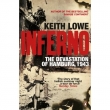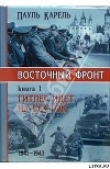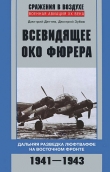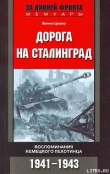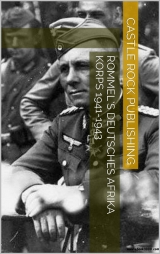
Текст книги "Rommel's Deutsches Afrika Korps 1941-1943"
Автор книги: Автор Неизвестен
Жанры:
История
,сообщить о нарушении
Текущая страница: 16 (всего у книги 19 страниц)
The end of March saw the beginning of the tightening of the noose around the Axis forces in Tunisia. From the probing attacks on the western and south-western sectors of the front the emphasis then fell upon the southern flank where 8th Army, having regrouped after the Mareth battles, was shepherding the desert veterans of 1st German/Italian Panzer Army into a killing ground towards a situation which would end the campaign.
The position which the Germans called the Schott line blocked the 18-mile gap between the Schott el Fedjadj and the sea. The battle which was foughi along this line is known to British military historians as the battle of Wadi Akarit. The Schott line ran from south of Djebel Heidoudi, via Djebel Tebaga Fatnassa and Djebel Roumana along the Wadi Akarit to the Mediterranean. The coastal plain north-west of Gabes is only five miles wide at its narrowest point and across the greatest part of this is the steep-sided, deep, anti-tank obstacle of the Wadi Akarit. The mountains of the Schott el Fadjadj were impassable to tanks coming from the west and the only danger lay on the western flank behind the Schott line for, from the direction of El Geuttar and Maknassy, strong United States tank forces might drive and overwhelm the 10th Panzer Division which held the position near those places.
The battles at Mareth had weakened the Axis forces and quoting the War Diary of 164th Division, it was calculated that at El Hamma manpower losses had amounted to 1100 men. The rifle strength of 164th Division was down to the equivalent of three understrength battalions although two companies from a replacement battalion belonging to 15th Panzer Division came on strength from 30 March. The usual divisional components were equally weak and the artillery support was still only a single battery. Acutely aware of the impotence of his forces and the even more serious inability of the Italians to defend their positions, Rommel deployed his forces so that the Germans held the sensitive areas. Italian XX Corps, with 90th Light under command, guarded the coast road while 164th Division under XXI corps, took up position on that Corps' right flank around and east of Djebel Heidoudi. The mountain positions were all held by Italian troops and to maintain contact with Panzer Army Africa's main body and von Broich's 10th Panzer Division battle group, the Sahara Group carried out wide-ranging and frequent patrolling. There were several major movements of armour as a result of which 21st Panzer Division was posted to 5th Panzer Army, leaving 15th Panzer Division in Army reserve and positioned behind Army's left wing.
The whole Axis front lay waiting throughout the long nights of the last week of March for 8th Army's new blow to fall and in anticipation of this the outpost line in position on a low ridge three miles in front of the main body was withdrawn. The first British attack came in on the night of 3/4 April and positions were lost by Trieste Division. A counter-attack by 90th Light won these back but these were only probing attacks by the British whose main assault came in at dawn on 6 April, behind a heavy artillery barrage. At Djebel Tebaga a silent night attack by Gurkha troops and carried out before zero hour had captured the crest of the mountain before the main attack went in. By lO.OOhrs on 6 April the front held by both Trieste and Spezia Divisions had been breached and Djebel Roumana and Djebel Tebaga Fatnassa had both been lost. The 164th Division, minus the battalion from 15th Panzer, was then moved to a point behind the front centre of the line to act as Army reserve and, as the division was moving, the order came for the non-motorised units to begin their withdrawal to the Enfidaville position while the German Panzer units held the line. The Schott line could not be held and the Axis armies were moving back to new defensive positions.
But even as the rearward movement was taking place a fresh British thrust carried past the right wing of 164th Division and broke through the Sahara patrol group forcing it to give up more ground under British pressure. The Panzer Army moved back to occupy another temporary line south-west of Agareb on 9 April and, when the final stages of the retreat had been concluded on llth, 164th and 90th Light were in position to the south-west of Enfidaville.
This new line was the southern face of the Axis-held area of Tunisia and had such excellent defensive features that it was considered to be the last ditch defence. Possession of the high ground around Djebel Zaghouan dominated a network of main roads: the Kairouan—Pont du Fahs highway, the Sousse– Enfidaville—Tunis road, and the Sousse—Enfidaville—Gromballia—Tunis road. Thus the high ground and particularly Djebel Garci, a steep and bare feature with several crests, dominated any advance from Sousse into the plains around the capital city.
To hold the last ditch positions XXI Corps held the right sector and had under command Spezia and Pistoia Divisions and the Luftwaffe Infantry Brigade. The Italian XX Corps held the left flank with Trieste, Young Fascist, and 90th Light Divisions. As usual the. German units held the most threatened sectors. The 164th Division was blocking the Pont du Fahs road, east of Djebel Garci the Luftwaffe Brigade dug in to control the Zaghouan road, while 90th Light covered the Enfidaville-Gromballia highway. The Italian units held the high ground with Spezia on the extreme right flank and Trieste and Young Fascist Divisions on either side of Takrouna. A secondary defence line behind the Young Fascist positions was held by non-armoured units from 15th Panzer. Parts of 10th Panzer came under command of Africa Corps and were located on the far right flank where they were joined some weeks later by elements from 21st Panzer Division.
To help hold the line there was a sudden but small spate of reinforcements and the numbers reaching 164th Division enabled second battalions to be formed for 382nd and 433rd Regiments. Battalions and artillery detachments from other units were also taken on divisional strength but the greatest number of these, and all the artillery, flak, and Nebelwerfer batteries, were taken from 164th Division when the Allied offensive opened and were then posted to 5th Panzer Army.
One of the most warmly interesting of the letters dealing with the attitudes of the German rank and file at that time is the report written by a young regimental officer after a tour of inspection to the front line. He wrote:
'On 11 April in the burning sun of mid-morning I saw eight men of 1st Battalion marching along the Kairouan—Enfidaville road in full equipment carrying arms and extra ammunition. They had had no food and had already marched for 25 miles before I met them. They were on their way to new positions at Zaghouan and refused my offer of a lift to any wounded saying that they would do the "little bit" of a march to Zaghouan. They arrived at battalion before nightfall.'
There was quiet along the sector held by 164th Division until the morning of 16 April when British artillery began to 'range in' and patrolling activity was reported. Three more days of calm passed but then Pistoia Division was hit during a night attack. The reconnaissance detachment of 164th Division, acting as reserve, was brought forward to capture the positions which the Italians had abandoned and on 21 April the Italians made their own counter-attack but this collapsed and broke in the face of British artillery fire. It was clear that Pistoia could no longer be considered an effective fighting force and it was removed from the line.
The next Italian division to come under the hammer blows of Montgomery's Army was Young Fascist but it held its ground on the Takrouna heights despite fierce attempts to drive it back, while on the Enfidaville plain the 90th Light was heavily engaged. A minor adjustment of the line to shorten this and thus to release men was carried out and these units were then sent to help the hard-pressed Hermann Goering Division north-west of Pont du Fahs. On 29 April the Spezia Division was forced off the heights which it had held.
The absence of British armour on the Enfidaville front pointed to the fact that 8th Army's tank divisions had been moved and, obviously, to Medjez el Bab from which sector would come the decisive blow. All anti-tank weapons on the southern flank were therefore rushed to the threatened western sector. Montgomery was fulfilling his plan to make the Germans 'run like wet hens' between the two Allied armies.
There were no other major British offensives against 164th Division and it remained inactive while the offensive through Medjez el Bab brought about the fall of Tunis. It is now to the battle front at that town that we return and to when, during the latter weeks of March, the American, British, and French forces having been regrouped, were preparing to make the thrust which would end the war in Africa.
The End in Afrika
The air of resigned acceptance which is so evident in the OKW War Diary entry for 31 March, that 'no new Allied thrusts have been made on the front of 5th Panzer Army', indicates how completely the initiative had passed into Allied hands and the realisation that the end of the war in Africa was only a question of time.
German planners were in no doubt that the Allies were concentrating their forces for the decisive battle. As a first step there was a reshuffle of forces which brought II United States Corps to face Manteuffel's Division and in the battle line around Medjez there were several British infantry divisions, freshly arrived from the United Kingdom, as well as the advanced guards of those desert formations which were eventually to be in the van of the battle for Tunis. [27]

Steady pressure exerted all through the last weeks of March had reduced the bridgehead area. The Medjez sector blazed into activity as British attacks came in against 334th Division on 7 April, and fighting for strategically important mountain crests continued for days. South of Medjez el Bab, there were struggles to win commanding positions around Fondouk. To the northwest of Medjez el Bab the 78th Infantry Division captured Longstop during Easter week thus regaining a feature which had been in German hands since Fischer's December offensive.
The fires of battle reached other sectors of the British front and the Hermann Goering Division came under almost continuous assault from the middle of the month although it met every British attack with a counter-attack and by such spirited defence actually lost very little ground. This German elite formation was used to spearhead an operation to determine the location of the British concentration area behind the Medjez front and [28] by attack to delay the British preparations. This operation, code-named Fliederblute, a combined panzer/grenadier attack, was launched during the night of 19/20 April.

The sky behind the German line was alight with gun fire as the barrage opened the advance, with a panzer wave escorted by paratroops of the Herman Goering Division clinging to the outsides of the vehicles. The 2nd Battalion the Duke of Cornwall's Light Infantry was overrun as the armoured vehicles swept across their positions but the 25-pounder guns of 4th Division's artillery fired all night until by dawn when, with their mission accomplished, the German panzers and their Grenadiers rolled back across their start line. Through this reconnaissance in force it was clear to 5th Panzer Army that a massive build-up of Allied strength was in progress and this in a sector with few natural defences. Army Group looked for units which it could put into the threatened sector to thicken the line and moved 10th Panzer from its positions in the south, for it seemed that the Enfidaville line would be strong enough to hold.
Despite local losses this line did, in fact, hold and as the mountains absorbed the Allied strength, so more and more German troops could be transferred to the central sector. Army group intelligence appreciations located an iron ring around the Axis armies made up of 1 French and 3 American divisions on the extreme northern sector and to the west of Mateur,
5 British divisions in the Medjez el Bab area, 2 British and 2 American divisions in the Pont du Fahs region, a French Corps south of that place, and 6 British or Imperial divisions, as well as 2 brigades situated along the Enfidaville line. Of this great force no less than 7 were armoured divisions and when Montgomery moved part of his army from Enfidaville to Medjez el Bab the British had poised for battle in this sector, 2 armoured divisions and 2 armoured brigades to spearhead an attack which would be followed by 5 infantry divisions.
The panzer regiment of 21st Panzer Division was moved north and shortly thereafter followed all the anti-tank weapons which could be spared. The 15th Panzer Division moved its panzer regiment towards the central sector and located the main of division to the west of Tunis, ready to meet a deep Allied thrust.
Throughout April the Allied attacks continued, growing in frequency and intensity. From north to south small actions flared along the battle front as new units were 'blooded' in battle. But this was sometimes a 'bloody' affair for the attackers and in the battles around Peter's Corner, a bend in the Medjez-Tunis road, infantry battalions of 4th British Division lost heavily battling against the skilful, battle-hardened, and unshaken veterans of Koch's 5th Para Regiment and the Hermann Goering Division.
It is undeniable that under this Allied pressure a certain confusion existed as units moved, dug in, and received orders to move again. One officer wrote:
'Here the situation changes hourly. An order is followed by a counter-order. Since 11th (April) the fighting has entered its final stages and the task of maintaining the bridgehead is really only a question of time. With men alone we could hold the front b'ut materially we are in an inferior position. The Luftwaffe cannot supply us and that which comes by sea is a drop in the ocean ... we are on the defensive because we cannot fight tanks with the bodies of men and with shot guns. Yesterday Battle Group Wolff had one 7.5cm pak and a 5cm pak. The latter did not work.'
The pattern of Allied tactics was now to secure jump-off points for the final assault and the German units were switched from one threatened sector to another. One battle group commander reported that his unit had withdrawn 50 miles without loss and that the sector he was presently holding was seven miles wide. Of another battle group commander it was said that he had not slept for four days. In the north 334th Division and the Barenthin Regiment fought desperately to deny Hill 609 to the Americans but the pressure was too great and by the end of April American troops had attained the last commanding height west of Mateur. In the north ManteuffeFs Division slowly gave ground as it carried out a fighting withdrawal on Bizerta and 962nd Regiment of 999th Division, moving back to new positions, turned at bay to face the Allied units which were pressing close upon it. A report written by Sergeant Scharwachter of No 5 Company 962nd Regiment, who was wounded and flown back to Germany, gives details of the fighting:
'American troops whose lines lay between one and five miles distant from our own crossed a mine-field in 'no man's land' to begin their attack on 25 April. They went to ground under our fire but under a well co-ordinated barrage they soon worked their way to within hand grenade range. My platoon covered the withdrawal of our battalion to higher ground and was heavily engaged. We had heavy losses because my men had had no recent combat experience. One 42-year-old man who had been convicted of treason and who had helped to beat back the American assaults said to me, "Sergeant, I don't care what happens now. I have redeemed my honour" and another man stood up in his slit trench firing a machine gun from the hip and driving back the advancing Americans until he was wounded.'
But even fighting such actions they could not hold back the Allied drive and Mateur was occupied by 3 May. It was now clear that, however desperately Army Group shuffled its available forces, these were neither sufficient in number, nor logistically capable of withstanding the anticipated blow. Units were being overrun by the advancing Allies. Colonel Wolff reported on one unit of his division which was overtaken by the speed of the Allied drive: 'Three hundred men were isolated behind the enemy lines but now have fought their way back to us. Some were missing for more than 10 days. One group is reported to be still free and is being fed by Arabs. They are still hoping to break through to us.'
Army group echeloned its effectives in depth along the line which they expected the British attack to follow and had brought into the final battle a miscellaneous collection. Batteries of 20th Flak Division, whose principal task it had been to defend the Tunisian cities from air raid, found themselves grouped to the south-west of the capital preparing to fight in a ground role and the last 30 vehicles of 10th Panzer were moved from the Medjerda river line and placed as a deep reserve in the Massicault area.
Contemporary diaries, letters, and reports show that in those last anxious days the morale of the front line soldier remained high. Colonel Wolff, describing the military situation in the Pont du Fahs area, finished one letter 'so we live in our little kingdom and only through the radio do we know what is happening in the outside world and in Tunisia. The flies pester us but we are happy.'
There was no breakdown in discipline even at the end and in 999th Penal Division the only case of military justice being exercised was in the execution of five men for trying to kill an NCO. The officers' letters are full of praise for the spirit of their men; 'As is to be expected the spirit of the men in the front line is excellent but that of rear echelon units is less so. In Tunis town there are many drunken soldiers to be seen and lack of proper salutes indicates a certain slackness.' But, if contemporary accounts stress the high morale, very few of the many acts of heroism were detailed – even fewer received recognition. It is to be hoped that some staff officer at army headquarters would have found time to accede to the request of one regimental officer who, proud of the way in which his company of military criminals had fought, made application that the men of 999th Division who had been active in the fighting should have their military honour restored to them before the campaign ended. In this he was asking for recognition which the bravery of some of the men of his unit had already gained for themselves in the award of Iron Crosses.
On 5 May an artillery and air bombardment of unparalleled ferocity crashed down upon the German positions. Breaches made in their lines were sealed by desperate attacks put in by the last remaining vehicles of 15th Panzer and by anti-tank units. One unnamed staff captain reported that one unit of his command in the Pichon area 'fired the anti-tank guns to the last round and were then rolled over by American tanks. The infantry fought their way out but on entering positions believed to be held by Italians found these to be occupied by Goums. By nightfall we had only 25 men left although stragglers have been coming in.' Through the breaches which the artillery and air bombardment had made, poured a flood of Allied armour and infantry whose long pent-up energy cast aside any counter-attacks which Army Group could still launch.
By the evening of 6 May, Massicault had fallen and the word was spread to commanders of German units that Tunis was to be evacuated by 17.00hrs on 7th. Early in the morning of that day the first evacuations began to take place although outwardly the city seemed calm and German soldiers still went about their usual business. Then in the drizzle which had set in towards 14.00hrs armoured cars of llth Hussars or the Derbyshire Yeomanry – the point is debated still – entered Tunis as the first British troops. In the north Bizerta fell to the Americans on the same day. Army Group Africa had been split in two and 5th Panzer Army swung back to the north while 1st Panzer Army sought to establish a firm line south-west of Tunis.
When Tunis fell there were many who made long and difficult journeys from an airfield to a port and back to another airfield hoping to find a ship or aircraft which would take them from the dying front and enable them to escape to continue fighting in another theatre of operations. One subaltern officer spent the last hours before the fall of Tunis in negotiations with pilots of JU 52 transport aircraft to fly back to Sicily a divisional staff which had reached Africa only 48 hours before. His successful negotiations earned him a place in the machine but it was shot down and, slightly concussed, he had to swim from the machine and back to shore. Five hours after the first British troops had entered the city the last of the JU 52s took off and the same officer managed to squeeze himself with three others and the pilot into a single-seater fighter and to land unharmed in Sicily.
Resistance was still being offered outside the cities. In the north American and French troops crossed the Chouigui pass and cut off much of 334th Division and the flak batteries to the south-west of the city fired to such good effect that they destroyed 20 tanks of one American spearhead. Other short-lived and purely local successes were scored by German units whose vehicles no longer had fuel to move them and whose crews fought and died where they stood.
The 15th Panzer, which still had some fuel, carried out one last counterattack north of Djebel Kechabta and during this battle fired its last ammunition. The last shots by the last German tanks were fired on 9 May to cover the removal of 5th Panzer Army's tactical headquarters and then the vehicles were blown up. With them died the 5th Panzer Army.
The line now held by the remnants of Army Group Africa was based on Hamman Lif and the Cap Bon peninsula but however much deployment and redistribution of troops might take place, the fighting was akin to the dying struggles of a Titan. When the British came in along the line from Creteville to Zaghouan the last German units, in obedience to the Fuhrer Befehl to fight to the last round, defended their positions until the ammunition ran out and then destroyed their vehicles and weapons before surrendering. The 10th Panzer Division, as an example, dug in its last seven panzers which were completely without fuel to serve as pill boxes and carried on fighting around these for as long as there was ammunition. On 11 May the wireless waves were alive with sound as unit after unit, having obeyed Hitler's order to the last round went off the air and into captivity.
On the morning of 12 May von Arnim, conscious that Army Group Africa could no longer offer any organised resistance, asked for surrender terms and on the following day 164th Division – the last unit of the Axis armies in Africa – marched out and into prisoner-of-war compounds, fully aware that it, like the rest of Army Group Africa, had done its duty.
Chronology
12 November 1940:OKW issues Instruction No 18 that a force be raised to support the Italians in North Africa for an autumn attack upon Egypt.
16 January 1941:According to Hitler the purpose of German intervention in Libya is to prevent the collapse of the Italians. A blocking force is to be raised and sent.
6 February 1941:Erwin Rommel named as commander of German Troops in Africa and arrives in Tripoli.
12 February 1941:The first German air raid on Benghasi.
19 February 1941:The German force in Africa is named 'German Africa Corps'.
22 March 1941:The Africa Corps advances and captures El Agheila.
2 April 1941:The Africa Corps goes on to seize Agedabia.
8 April 1941 The battle of Mechili.
12 April 1941:The first assaults upon Tobruk. The capture of Bardia and Sollum on the Egyptian frontier forms an eastern outpost for the Axis army.
15 June 1941:The tank battle at Sollum defeats Wavell's attempt to capture Halfaya.
5 August 1941:Panzer Group Africa is formed.
18 November 1941:Operation Crusader, an attempt to raise the siege of Tobruk, opens.
23 November 1941:The battle of Sidi Rezegh smashes 7th Armoured Division
2 December 1941:Operation Crusader ends with a German tactical victory.
7 December 1941:Faced with the resumption of a. new British offensive the Axis forces are withdrawn to the Gazala position.
17 January 1942:The Axis garrison at Halfaya surrenders.
21 January 1942:Rommel's counter-offensive to recapture Cyrenaica opens.
28 January 1942:Rommel recaptures Benghasi.
30 January 1942:Panzer Army Africa (the German/Italian Panzer Army) is formed
February 1942:The air offensive against Malta begins.
26 May 1942:Rommel's offensive against the Gazala position opens.
2 June 1942:The siege of Bir Hachim at the southern end of the Gazala line begins.
20 June 1942:Having destroyed 8th Army's armoured force, Rommel's force goes on to capture Tobruk.
22 June 1942:The advance begins across Egypt towards the Suez canal.
29 June 1942:Mersa Matruh falls to the Axis Troops.
1 July 1942:The first battle of El Alamein begins.
9 July 1942:The battle of Alam Haifa opens.
30 August 1942:The German armour breaks through at El Alamein but is unable to force a decision.
2 September 1942:The German offensive at El Alamein is broken off.
23 October 1942:Montgomery's offensive at El Alamein begins.
2 November 1942:The 8th Army breaks through the El Alamein front.
4 November 1942:The Axis forces retreat to the Fuka line.
8 November 1942:Operation Torch begins; the landing of the British and Americans in French North Africa.
19 November 1942:German paratroops occupy Gabes aerodrome and other detachments launch an offensive against Medjez el Bab.
20 November 1942:In the second stage of their withdrawal the Axis forces reach the Marsa el Bregha position.
6 December 1942:The offensive by 10th Panzer Division in Tunisia drives back the Allied armour in Blade Force
8 December 1942:The 5th Panzer Army is formed in Tunisia.
24 December 1942:The British assault against the Buerat Line.In the Medjez el Bab sector the Germans capture Longstop Hill.
22 January 1943:The last German units evacuate Tripolitania and cross into Tunisia.
12 February 1943:The desert army and 5th Panzer Army link up in Tunisia. Rommel reaches the Mareth position and prepares for the forthcoming battle.
15 February 1943:The Axis offensive against Gafsa and Sidi bou Zid begins.
20 February 1943:Initial successes at Gafsa and Sidi bou Zid having been scored by the Axis forces, the advance upon Thala and Le Kef is begun.
23 February 1943:Army Group Africa is formed.
6 March 1943:The last major German attack in Africa is made at Mareth and fails on the same day.
20 April 1943:The 8th Army reaches the Enfidaville position, the last ditch defences of the Army Group Africa before Tunis.
3 May 1943:The Allies break through at Mateur and capture it.
5 May 1943:The British offensive opens at Medjez el Bab.
7 May 1943:Tunis falls to the British and Bizerta to the United States forces.
13 May 1943:The Axis armies in Africa capitulate.
Tank Engagement at Sollum
Rommel alerted the Sollum Front on 14 June. The tanks of the 5. leichtc Afrika-Division were directed into tactical assembly areas from which they could easily move out against the Sollum Front, if needed.
On 15 June, the British started Operation "Battleaxe." The formations of the "Desert Rats" assaulted from the south. It was the first time they were to encounter Panzer-Regiment 8. Some of the British forces were armed with the Matilda, a heavy infantry tank. Its 80-millimeter-thick armor plate was impervious to all German tank main guns at the time. Only the 8.8-centimeter Flak was capable of knocking it out.
Halfaya Pass was attacked at the same time and, just as the Germans had done, from two directions. Capuzzo fell to the enemy that evening. The 15. Panzer-Division was directed to attack Capuzzo on 16 June and take the fort back from the enemy.
The fighting see-sawed back and forth, with each side launching armored assaults against the other's perceived weaknesses. In one such counterattack. Oberstleutnant Cramer personally accompanied the II./Panzer-Regiment 8. He observed how one tank after another was knocked out, and the Matilda seemed impervious to his tanker's main guns. As all this was happening, i group of about 20 other tanks rapidly advanced against the left wing of the regiment.
Oberstleutnant Cramer took immediate countermeasures: "Kiimmel, turr_ and engage the approaching enemy!"
Kummel's company turned and approached the advancing enemy. His short-barreled 7.5-centimeter main guns opened fire at a short distance from the enemy.
The first Mark II went up in flames. First three, then a fourth Mark II turned towards Kummel's vehicle. With a violent impact, the first roun; thudded into the ground to the right in front of Kummel's command tank
It covered the vehicle with a fountain of dirt. The flash from the detonation lit up the interior of Kummel's tank. Before the enemy could get off a second round, however, Kummel's gunner acquired him in his sights and clobbered him with a direct hit between the turret and hull.
Kummel's crew worked like madmen. Whenever the next round was rammed home and the breechblock snapped shut, the gunner had another target in his optics. The gun reported, and the empty shell casing smashed against the round deflector and landed in the spent-casing sack. While all this was going on, driver Kruschinski was racing about madly to avoid allowing die enemy the chance to acquire them. By the end of this round of fighting, fcunmel's tank alone had accounted for eight of the enemy. From that point rorward, Johannes Kummel was known as the "Lion of Capuzzo."


